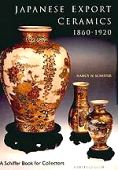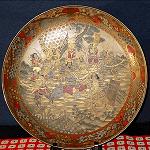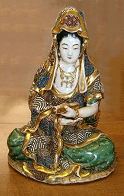 The ancient Japanese province of Satsuma was located in the southernmost part of the island of Kyushu. Its association with the production of pottery and earthenware was well known by the early 17th century. Most of the early Satsuma ware was simply made and featured a cream colored body with a slightly yellowish glaze that was finely crackled like the background of this page. This crackled glaze remains a hallmark of collectible Satsuma to this day. Designs were done with no perspective, and of limited palette. The prince of Satsuma on Kyushu Island established a kiln with the help of Korean potters. Satsuma ware from this time is made of brown clay.
The ancient Japanese province of Satsuma was located in the southernmost part of the island of Kyushu. Its association with the production of pottery and earthenware was well known by the early 17th century. Most of the early Satsuma ware was simply made and featured a cream colored body with a slightly yellowish glaze that was finely crackled like the background of this page. This crackled glaze remains a hallmark of collectible Satsuma to this day. Designs were done with no perspective, and of limited palette. The prince of Satsuma on Kyushu Island established a kiln with the help of Korean potters. Satsuma ware from this time is made of brown clay.
Western interest in Japanese arts and demand grew at a rapid rate, most notably with the world trade exhibitions that flourished in the late 19th Century and early 20th Century, in which Japanese pavilions were visited by eager viewers and collectors. One of the most important of these, in terms of Satsuma wares, was the Paris Exhibition of 1867.
 Satsuma is produced at lower temperatures than porcelain. In the late eighteenth century Satsuma was so popular that clay from the Kyushu Island was brought to Awata near Kyoto to produce Satsuma ware - now known as Kyoto Satsuma ware. Most of the Kyoto Satsuma ware was produced for export to Western countries.
Satsuma is produced at lower temperatures than porcelain. In the late eighteenth century Satsuma was so popular that clay from the Kyushu Island was brought to Awata near Kyoto to produce Satsuma ware - now known as Kyoto Satsuma ware. Most of the Kyoto Satsuma ware was produced for export to Western countries.
Satsuma earthenware is somewhere between porcelain and pottery. They were painstakingly painted with thick enamels and gold leaf, often in elaborate decoration and depicting themes directly from the Japanese ethos of legends, court life, and artistic values. These are highly sought after by a growing body of collectors all over the world.
 The characteristics of Satsuma ware are rich decorations with gold and polychrome colors on a soft, ivory-colored, crackled glaze. Typical for the decoration of Satsuma ware is the use of Gosu blue, a highly saturated blue glaze. The technique of Gosu blue was developed in the nineteenth century.
The characteristics of Satsuma ware are rich decorations with gold and polychrome colors on a soft, ivory-colored, crackled glaze. Typical for the decoration of Satsuma ware is the use of Gosu blue, a highly saturated blue glaze. The technique of Gosu blue was developed in the nineteenth century.
Satsuma statuary is a popular area of satsuma collecting. Some typical subjects include samurai, peasants, bijin, fishermen and mythical and mystical beings like the Shakyamuni Buddha and the Kannon (a.k.a Kwan Yin), the Japanese Goddess of Mercy, a Bodhisatva, or being of enlightenment, which embodies compassion and is one of the most widely worshiped divinities in Japan and mainland Asia.
Closeups of the statues on this page and every sculpture in the Villa Del Prado Light of Asia Collection can be found on the main page.
 The ancient Japanese province of Satsuma was located in the southernmost part of the island of Kyushu. Its association with the production of pottery and earthenware was well known by the early 17th century. Most of the early Satsuma ware was simply made and featured a cream colored body with a slightly yellowish glaze that was finely crackled like the background of this page. This crackled glaze remains a hallmark of collectible Satsuma to this day. Designs were done with no perspective, and of limited palette. The prince of Satsuma on Kyushu Island established a kiln with the help of Korean potters. Satsuma ware from this time is made of brown clay.
The ancient Japanese province of Satsuma was located in the southernmost part of the island of Kyushu. Its association with the production of pottery and earthenware was well known by the early 17th century. Most of the early Satsuma ware was simply made and featured a cream colored body with a slightly yellowish glaze that was finely crackled like the background of this page. This crackled glaze remains a hallmark of collectible Satsuma to this day. Designs were done with no perspective, and of limited palette. The prince of Satsuma on Kyushu Island established a kiln with the help of Korean potters. Satsuma ware from this time is made of brown clay.
 Satsuma is produced at lower temperatures than porcelain. In the late eighteenth century Satsuma was so popular that clay from the Kyushu Island was brought to Awata near Kyoto to produce Satsuma ware - now known as Kyoto Satsuma ware. Most of the Kyoto Satsuma ware was produced for export to Western countries.
Satsuma is produced at lower temperatures than porcelain. In the late eighteenth century Satsuma was so popular that clay from the Kyushu Island was brought to Awata near Kyoto to produce Satsuma ware - now known as Kyoto Satsuma ware. Most of the Kyoto Satsuma ware was produced for export to Western countries.
 The characteristics of Satsuma ware are rich decorations with gold and polychrome colors on a soft, ivory-colored, crackled glaze. Typical for the decoration of Satsuma ware is the use of Gosu blue, a highly saturated blue glaze. The technique of Gosu blue was developed in the nineteenth century.
The characteristics of Satsuma ware are rich decorations with gold and polychrome colors on a soft, ivory-colored, crackled glaze. Typical for the decoration of Satsuma ware is the use of Gosu blue, a highly saturated blue glaze. The technique of Gosu blue was developed in the nineteenth century.
